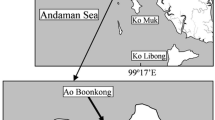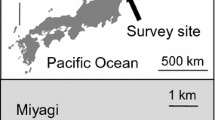Abstract
The fish assemblage structure response to rapid degradation of Enhalus acoroides seagrass beds due to overgrazing by green sea turtles (Chelonia mydas) was investigated at Iriomote Island, southern Japan, by visual censusing of fish species in several microhabitats in and around the beds (i.e., dense seagrass bed, grazed bed, their boundaries, and adjacent sandy area). Fish assemblage structure differed among the seagrass microhabitats, both species and individual numbers being higher in microhabitats with seagrass compared to overgrazed beds and unvegetated sandy areas, together with different species composition. In the dense seagrass beds and boundary areas (the border area between dense seagrass beds and grazed areas), seagrass-associated fishes such as the rabbit fish Siganus fuscescens and cardinal fish Ostorhinchus ishigakiensis were abundant and comparable with those in other seagrass beds in the area. In addition, the fish assemblages in those microhabitats varied seasonally, fish abundance being greater in summer due to higher levels of recruitment. In the grazed bed, benthic gobies, such as Ctenogobiops crocineus and Cryptocentrus caeruleomaculatus, were dominant (similarly so in unvegetated sandy areas), and seasonal variations in such assemblages were relatively low compared to those in dense seagrass microhabitats. The decrease in the abundance and diversity of seagrass-associated fish in the grazed areas could be explained partly by the shortage of vegetation (< 20 cm in leaf length) for shelter and feeding throughout the year. The results suggested that the degradation of seagrass beds due to overgrazing by green turtles has a deleterious effect on fish assemblages, and that future conservation and management strategies for seagrass beds should consider both their associated fish communities and green turtles.






Similar content being viewed by others
References
Abe O, Shibuno T, Takada Y, Hashimoto K, Tanizaki S, Ishii H, Funakura Y, Sano K, Okamura Y (2004) Nesting populations of sea turtle in Ishigaki Island, Okinawa. Proc 4th SEASTAR2000 Workshop 2004:40–43
Ansari ZA, Rivonker CU, Ramani P, Parulekar AH (1991) Seagrass habitat complexity and macroinvertebrate abundance in Lakshadweep coral reef lagoons, Arabian Sea. Coral Reefs 10:127–131
Chaloupka M, Bjorndal KA, Balazs GH, Bolten AB, Ehrhart LM, Limpus CJ, Suganuma H, Troëng S, Yamaguchi M (2008) Encouraging outlook for recovery of a once severely exploited marine megaherbivore. Glob Ecol Biogeogr 17:297–304
Christianen MJA, Herman PMJ, Bouma TJ, Lamers LPM, Van Katwijk MM, van der Heide T, Mumby PJ, Silliman BR, Engelhard SL, van de Kerk M, Kiswara W, van de Koppel J (2014) Habitat collapse due to overgrazing threatens turtle conservation in marine protected areas. Proc R Soc B 281:20132890
Dorenbosch M, van Riel MC, Nagelkerken I, van der Velde G (2004) The relationship of reef fish densities to the proximity of mangrove and seagrass nurseries. Estuar Coast Shelf Sci 60:37–48
Edgar GJ, Shaw C (1995) The production and trophic ecology of shallow-water fish assemblages in southern Australia. I. Species richness, size–structure and production of fishes in Western Port Victoria. J Exp Mar Biol Ecol 194:53–81
Fourqurean JW, Manuel S, Coates KA, Kenworthy WJ, Smith SR (2010) Effects of excluding sea turtle herbivores from a seagrass bed: overgrazing may have led to loss of seagrass meadows in Bermuda. Mar Ecol Prog Ser 419:223–232
Green EP, Short FT (2003) World Atlas of Seagrasses. Prepared by the UNEP World Conservation Monitoring Centre. University of California, Berkeley
Gullstrom M, Bodin M, Nilsson PG, Ohman MC (2008) Seagrass structural complexity and landscape configuration as determinants of tropical fish assemblage composition. Mar Ecol Prog Ser 363:241–255
Heck KL Jr, Hays G, Orth RJ (2003) Critical evaluation of the nursery role hypothesis for seagrass meadows. Mar Ecol Prog Ser 253:123–136
Horinouchi M (2007) Review of the effects of within-patch scale structural complexity on seagrass fishes. J Exp Mar Biol Ecol 350:111–129
Horinouchi M (2009) Horizontal gradient in fish assemblage structures in and around a seagrass habitat: some implications for seagrass habitat conservation. Ichthyol Res 56:109–125
Horinouchi M, Nakamura Y, Sano M (2005) Comparative analysis of visual censuses using different width strip-transects for a fish assemblage in a seagrass bed. Estuar Coast Shelf Sci 65: 53–60
Horinouchi M, Tongnunui P, Nanjo K, Nakamura Y, Sano M, Ogawa H (2009) Differences in fish assemblage structures between fragmented and continuous seagrass beds in Trang, southern Thailand. Fish Sci 75:1409–1416
Hughes JE, Deegan LA, Wyda JC, Weaver MJ, Wright A (2002) The effects of eelgrass habitat loss on estuarine fish communities of southern new England. Estuaries 25:235–249
Kameda K, Wakatsuki M, Kuroyanagi K, Iwase F, Shima T, Kondo T, Asai Y, Kotera Y, Takase M, Kamezaki N (2017) Change in population structure, growth and mortality rate of juvenile green turtle (Chelonia mydas) after the decline of the sea turtle fishery in Yaeyama Islands, Ryukyu Archipelago. Mar Biol 164:164–143
Kelkar N, Arthur R, Marba N, Alcoverro T (2013) Green turtle herbivory dominates the fate of seagrass primary production in the Lakshadweep islands (Indian Ocean). Mar Ecol Prog Ser 485:235–243
Lal A, Arthur R, Marbà N, Lill AWT, Alcoverro T (2010) Implications of conserving an ecosystem modifier: Increasing green turtle (Chelonia mydas) densities substantially alters seagrass meadows. Biol Conserv, 143:2730–2738
Nagelkerken I, Roberts CM, van der Velde G, Dorenbosch M, van Riel MC, Cocheret de la Morinière E, Nienhuis PH (2002) How important are mangroves and seagrass beds for coral-reef fish? The nursery hypothesis tested on an island scale. Mar Ecol Prog Ser 244:299–305
Nagelkerken I, van der Velde G, Gorissen MW, Meijer GJ, van’t Hof T, den Hartog C (2000) Importance of mangroves, seagrass beds and the shallow coral reef as a nursery for important coral reef fishes, using a visual census technique. Estuar Coast Shelf Sci 51:31–44
Nakabo T (ed) (2013) Fishes of Japan with pictorial keys to the species, third edition. Tokai University press, Hadano
Nakamura Y (2010) Patterns in fish response to seagrass bed loss at the southern Ryukyu Islands, Japan. Mar Biol 157:2397–2406
Nakamura Y, Hirota K, Shibuno T, Watanabe Y (2012) Variability in nursery function of tropical seagrass beds during fish ontogeny: timing of ontogenetic habitat shift. Mar Biol 159:1305–1315
Nakamura Y, Horinouchi M, Nakai T, Sano M (2003) Food habits of fishes in a seagrass bed on a fringing coral reef at Iriomote Island, southern Japan. Ichthyol Res 50:15–22
Nakamura Y, Sano M (2004a) Is there really lower predation risk for juvenile fishes in a seagrass bed compared with an adjacent coral area? Bull Mar Sci 74:477–482
Nakamura Y, Sano M (2004b) Overlaps in habitat use of fishes between a seagrass bed and adjacent coral and sand areas at Amitori Bay, Iriomote Island, Japan: Importance of the seagrass bed as juvenile habitat. Fish Sci 70:788–803
Nakamura Y, Sano M (2005) Comparison of invertebrate abundance in a seagrass bed and adjacent coral and sand areas at Amitori Bay, Iriomote Island, Japan. Fish Sci 71:543–550
Nakamura Y, Tsuchiya M (2008) Spatial and temporal patterns of seagrass habitat use by fishes at the Ryukyu Islands, Japan. Estuar Coast Shelf Sci 76:345–356
Okamura O, Amaoka K (1997) Sea Fishes of Japan. Yama-kei, Tokyo
Orth RJ, Carruthers TJB, Dennison WC, Duarte CM, Fourqurean JW, Heck KL Jr, Hughes AR, Kendrick GA, Kenworthy WJ, Olyarnik S, Short FT, Waycott M, Williams SL (2006) A global crisis for seagrass ecosystems. Bioscience 56:987–996
Park JM, Kwak SN (2018) Seagrass fish assemblages in the Namhae Island, Korea: The influences of seagrass vegetation and biomass. J Sea Res 139:41–49
Senou H, Suzuki T, Shibukawa K, Yano K (2004) A photographic guide to the gobioid fishes of Japan. Heibonsha, Tokyo
Takeyama K, Kohno H, Kuramochi T, Iwasaki A, Murakami T, Kimura K, Ukai A, Nakase K (2014) Distribution and growth condition of Enhalus Acroides in Iriomote Island. Jour Japan Civil Engine Ser B3 70 (2):I_1068–I_1073
Thayer GW, Bjorndal KA, Ogden JC, Williams SL, Zieman JC (1984) Role of larger herbivores in seagrass communities. Estuaries 7:351–376
Toma T (1999) Seagrass from the Ryukyu Islands - I, Species and distribution. Biol Mag Okinawa 37:75–92
Waycott, M, Duarte CM, Carruthers TJB, Orth RJ, Dennison WC, Olyarnik S, Calladine A, Fourqurean JW, Heck KL, Hughes AR, Kendrick GA, Kenworthy WJ, Short FT, Williams SL (2009) Accelerating loss of seagrasses across the globe threatens coastal ecosystems. Proc Nat Acad Sci USA 106:12377–12381
Acknowledgments
We are grateful to K. Sakihara for assistance with fieldwork. Constructive comments on the manuscript from Graham Hardy and two anonymous reviewers were much appreciated. This study was supported by a grant for Study and Education from the Okinawa Regional Research Center, Tokai University.
Author information
Authors and Affiliations
Corresponding author
Additional information
Publisher's Note
Springer Nature remains neutral with regard to jurisdictional claims in published maps and institutional affiliations.
About this article
Cite this article
Inoue, H., Mizutani, A., Nanjo, K. et al. Fish assemblage structure response to seagrass bed degradation due to overgrazing by the green sea turtle Chelonia mydas at Iriomote Island, southern Japan. Ichthyol Res 68, 111–125 (2021). https://doi.org/10.1007/s10228-020-00775-1
Received:
Revised:
Accepted:
Published:
Issue Date:
DOI: https://doi.org/10.1007/s10228-020-00775-1




